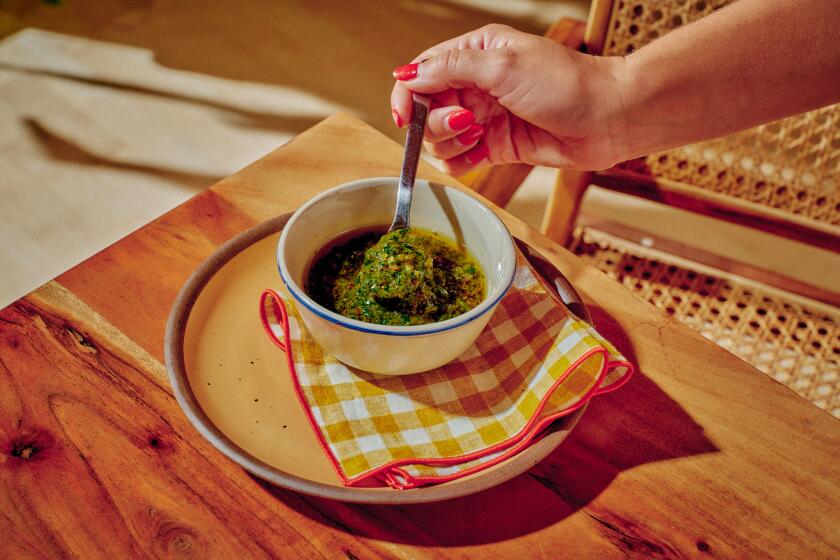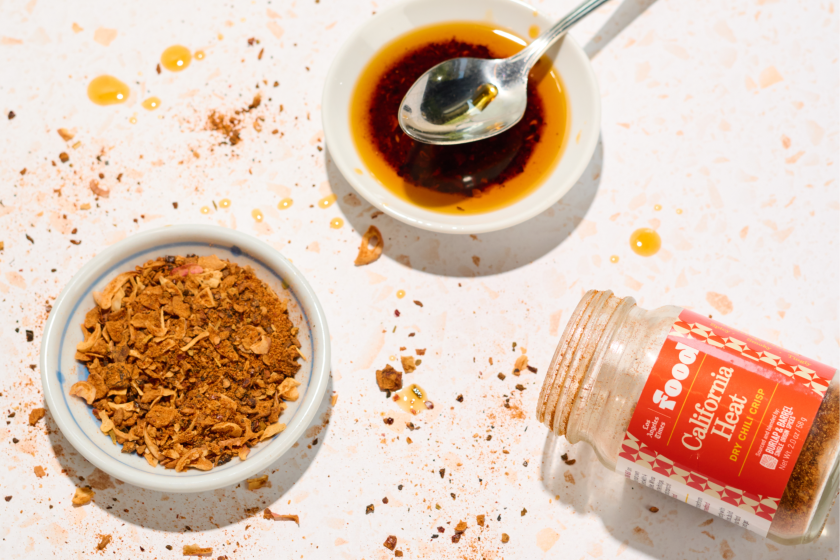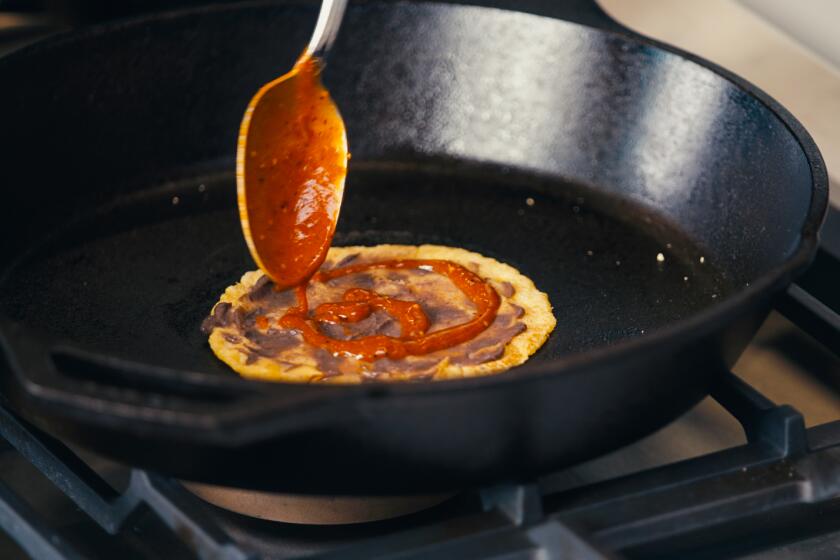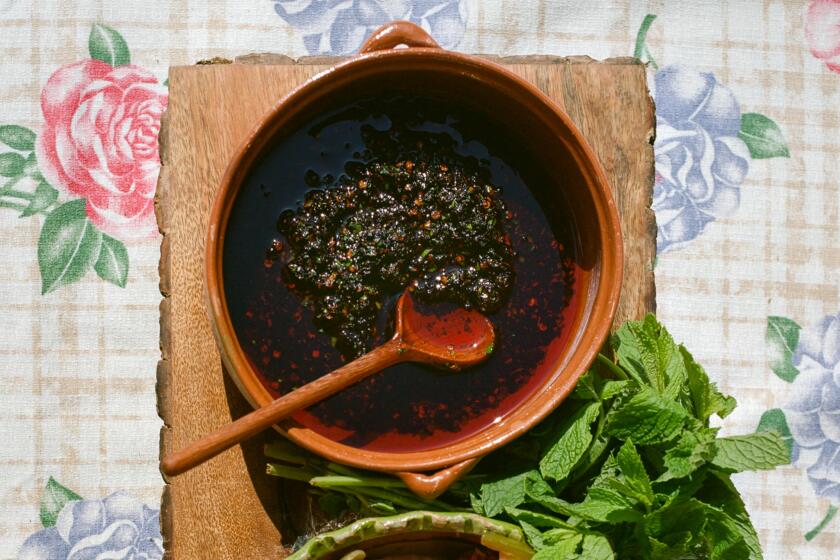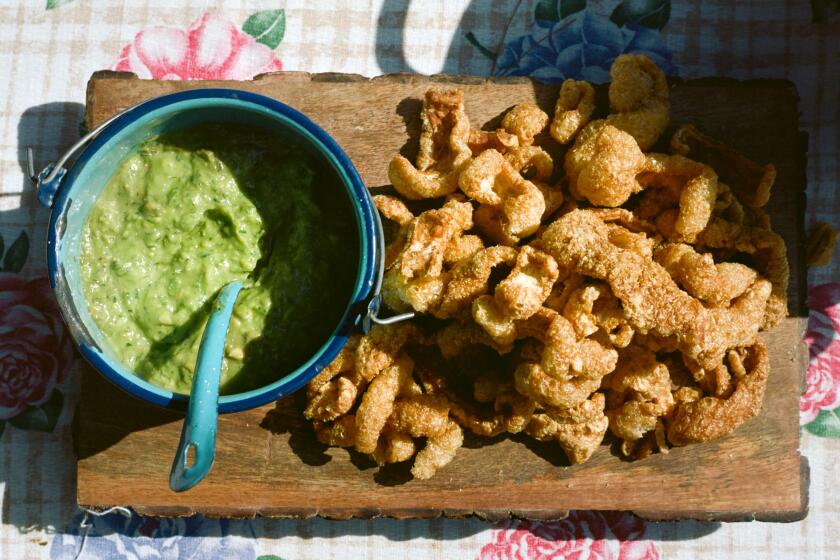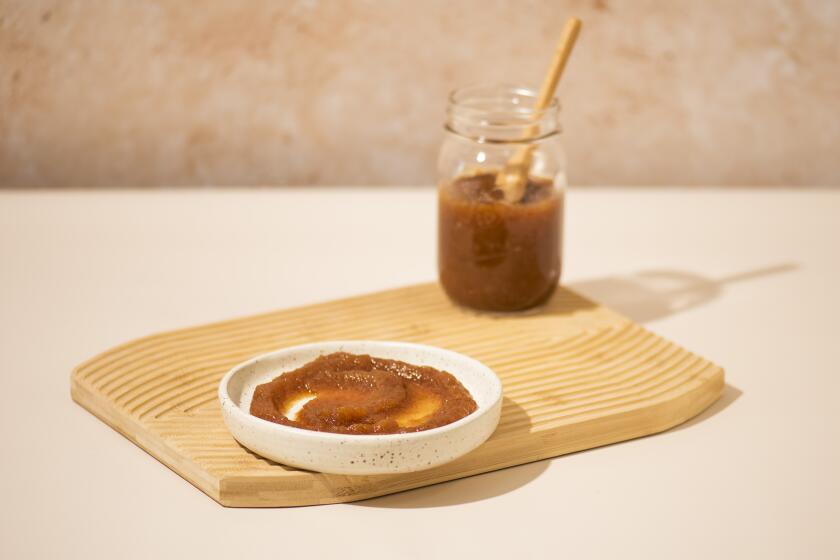Watermelon ketchup
- Share via
In these, the watermelon days of summer, it’s easy to think nature made this refreshing fruit just to slake our thirst and thrill kids who like to make a mess of their faces.
But its story is a long and curious one. Like the human race, the watermelon originated in Africa many thousands of years ago and has since developed in eccentric ways. There’s nothing quite like it. Whether buying it, eating it straight from the rind (as most of us do) or creating light and refreshing dishes with it, you can’t take it for granted. You’ve got to know it.
Originally domesticated in tropical Africa from a stringy, unpromising, sometimes bitter thing no bigger than a grapefruit, it had developed into the big boy we recognize by about 2000 BC, when it first showed up in Egyptian art.
But in recent centuries it has become the American melon. Sure, it spread throughout Europe and Asia during the Middle Ages, but not until the African slave trade brought it here did it really find an eager welcome. We Americans are the great watermelon fanciers of the world, the ones who’ve developed most of the improved varieties now grown.
Watermelons are an integral part of our summer folklore, and it makes sense that the biggest watermelon-eating season of the year is the week of July 4. There are more than 40 annual watermelon festivals around this country, meaning that there are more than 40 American towns that consider themselves the world capitals of watermelon.
Typically, these festivals feature exuberant contests for seed-spitting and growing the biggest watermelon. Curiously, though, plant breeders are now reversing gear on exactly these virtues.
On one hand, they’re racing to develop smaller melons. The traditional oblong “picnic” size is 17 to 20 pounds, and the familiar Calsweet variety can easily run 30 pounds, but the big push now is for melons under 15 pounds -- called “icebox” watermelons, because they’re small enough to go in the refrigerator without cutting -- and even cantaloupe-sized “lunchbox” or “one-meal” watermelons weighing under 5 pounds.
On the other hand, in 1988 growers introduced seedless varieties, beginning here in California. Of course, they’re not truly seedless -- they just have relatively few, relatively puny seeds. This makes them more difficult to propagate than seeded watermelons, so they’re somewhat more expensive.
But they now rule the California and Arizona watermelon industry, the third largest in the country; 90% of our state’s watermelons are seedless. “California’s lifestyle lends itself to convenience foods,” observes Dana Abercrombie of the California-Arizona Watermelon Assn. “Thus, seedless, smaller melons, the most popular size for the past 10 years being a 14- to 16-pound size, about the size of a basketball.”
Still, seedless varieties have to have seeded watermelons inter-planted with them so they’ll pollinate -- a row of Royal Sweet, say, for every few rows of seedless Millionaire (light green with thick, dark stripes) or Laurel (stripes of about equal size). So traditionalists, let not your hearts be troubled -- no matter how many seedless watermelons are grown, seeded watermelons will always be with us.
And that’s a good thing, because the watermelon’s tasty seed has always been one of its attractions. Toasted watermelon seeds are much appreciated in China, and some varieties have been specially bred for seeds (Wanli boasts a minimum of 400 seeds per melon). The original African wild watermelon, known by such names as tsama and egusi-ibara, is still being grown for its seeds, which are ground and used for thickening soups and stews throughout West Africa. Watermelon seed oil is also used for frying there.
A peculiar thing about watermelons is that they are rarely sold by variety. They’re rated on sweetness and crisp texture (neither mealy nor mushy), and little is made of distinctive aroma. “There aren’t the nuances in flavor in watermelon that there are in [other] melons,” says Amy Goldman, author of “Melons for the Passionate Grower.” “The differences are extremely subtle.”
Growers have developed more than 300 watermelon varieties, mostly to make the best of particular local growing conditions. Often a variety is said to be a “type” -- to resemble some old favorite. If you see a picnic-sized watermelon with a light-green rind and thin, dark-green stripes, that’s probably a Calsweet -- or a Calsweet type, adapted to some particular climate. A dark-green rind with rather erratic, broken, lighter stripes suggests a Sangria or, if the melon has a blockier shape, a Fiesta.
Even farmers markets have not featured many watermelon varieties so far. One grower that raises specialty watermelons is Weiser Farms, which sells in 20 Southland farmers markets. Alex Weiser tends to offer his melons from Lucerne Valley and Tehachapi in August and September, when the commercial crop from the Sacramento Valley is winding down.
This year he’ll have Golden Midget, a 3-pound watermelon with reddish flesh and a bright-yellow rind; Petite Yellow, an icebox-sized melon with yellow flesh; Mickylee, a dense-fleshed icebox variety he has been selling for some years; Blacktail Mountain, which Goldman characterizes in her book as “the gold standard by which my daughter and I judge all other watermelons”; and the striking Moon and Stars, which has a dramatic pattern of starlike yellow spots on its dark-green skin.
Why are watermelons sometimes disappointing?
“What happens, usually,” says Weiser, “they are picked overripe. Anything that is high in sugar breaks down faster. If you leave it on the vine too long, some of these melons are just apt to get mealy.”
Shelf time can cause loss of crispness too, he says. “Watermelons are at their prime for two weeks after you pick them. Past that stage, they start to get a little mealy. That even happens to a lot of the commercial ones. They sit out there until they sell. That’s why it’s hit or miss sometimes.” He says smaller operations that sell in farmers markets can keep better track of ripeness.
Texture aside, a watermelon’s flavor will suffer if it’s stored very long above 60 degrees. On the other hand, if it’s stored below 50 degrees too long, its flesh will lose color. And just a couple of days below 41 degrees is enough to make pits appear in the skin, and then bacteria will invade the watermelon and spoil the flavor. The term “icebox watermelon” doesn’t mean you should keep your melon there very long.
“People are worried about buying a bad watermelon,” says Abercrombie of the watermelon association. “After all, buying a watermelon is not like buying a grape. But you can ask to try a slice in the store. All the watermelons in the display should be the same.
“And if you take a watermelon home and find it’s not what you want, take it back. Stores have no problem with that.”
Chefs have a problem with the fruit, though. Watermelon, the anarchist of produce, just resists traditional preparation methods.
Before Bastide, the Melrose-area French restaurant, opened late last year, chef Alain Giraud planned to feature a watermelon soup, but he had to give up. He found the melon’s flavor refreshing but flat. “The only way to make more flavor is to reduce it, or caramelize it,” he says, “and then you would lose the original flavor. You have to add so many other things to make a flavor.”
So cooks tend to use watermelon in raw form, in salads and relishes, soups and beverages and sorbets. In fact, though, it is possible to cook watermelon. It’s often made into jam in China, and Mennonites in Russia traditionally used watermelon syrup as a sweetener.
However, two strange things happen when you cook watermelon, and both are likely to make you think you’ve made a terrible mistake. First, you’ll notice a flavor reminiscent of cooking pumpkin. “That’s due to breakdown products from fatty acids,” says food science writer Harold McGee. “They’re probably part of the plant’s defensive system. Microbes don’t like free fatty acids.” As the watermelon cooks down, this flavor becomes less prominent.
More interestingly, the aroma of stewed tomato also arises. This turns out to be caused by lycopene, which has twice as much antioxidant power as its close relative beta carotene. This might explain why chefs make things like watermelon-tomato salad. And maybe even why we were mysteriously impelled to turn watermelon puree into ketchup. You ought to try it.
“It’s the lycopene in tomato and watermelon, and some molecules that are on their way to making lycopene, that make that aroma,” says McGee. “Lycopene itself is not aromatic, but it’s a big molecule and under heat it can break up into aromatic fragments.
“At the same time, cooking destroys the cell walls of the plant tissue, making the lycopene more available to our digestions. So the breakdown of some of the lycopene actually signals that more nutrition is available. The aroma and the nutritional availability of lycopene are sides of the same coin.”
McGee points out one other thing about lycopene, whether you’re eating your watermelon raw or not: “Lycopene is insoluble in water, so plants tend to store it in crystals. That’s why you always want at least a little bit of oil or fat with the lycopene to dissolve it. If it stays crystallized, your digestive system might only be able to peel off the outer few molecules of the lycopene crystals.”
Eat something with a little fat in it along with watermelon at your Fourth of July barbecue? Hey, what are the chances of that? And you can just tell everybody it’s a lycopene thing.
Puree the watermelon in a food processor in 2-cup batches. You should have about 4 cups of puree. Press the puree through a strainer to remove fibrous material and seeds (even seedless watermelon has some seeds).
Transfer the juice to a 10-inch nonstick skillet, bring it to a boil over medium heat and then reduce the heat and simmer until thick, about 1 1/2 hours, stirring from time to time. Watch carefully toward the end to prevent scorching.
During the last five minutes of cooking, stir in the vinegar, mace, cloves and cinnamon. Taste and add more spices if you like. Makes about 1/2 cup.
Get our Cooking newsletter
Get a taste of Los Angeles — and the world — with recipes and kitchen tricks from the L.A. Times’ Cooking newsletter.
You may occasionally receive promotional content from the Los Angeles Times.










